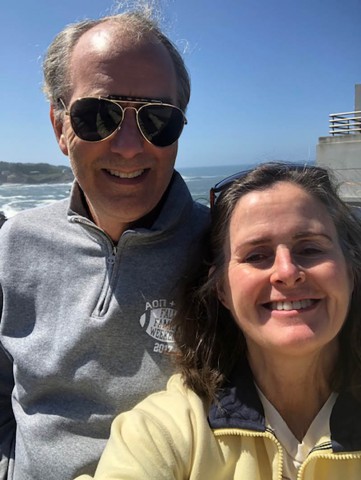
Survivor: Lynn Wiles
Date of Event:
Location of Event: At home, Albany, Oregon
Rescuer(s):Ken Wiles
It was a mundane morning for me and my wife Lynn. We went grocery shopping, stopped at the bank, and picked up something from the hardware store. We then returned home. All was well until Lynn’s heart happened to stop and I found her laying on the floor by the dining room table. I’ll never forget it.
On July 31, 2020 at 10:14am I called 911 and began administering cardiopulmonary resuscitation or CPR as Lynn, my wife of 17 years, lay lifeless. I could not find a pulse and she wasn’t breathing. A literal minute before I found her I was out at the curb unloading the car of its last two bags of groceries. Lynn was in the house putting them away.
My iPhone was on speaker sitting on the floor next to Lynn’s body as the 911 operator began instructing me on the art of CPR. I honestly don’t remember much of what the 911 operator was saying to me. My training from my college days as a lifeguard some 35 years prior kicked in and just like it was yesterday, I began the chest compressions and mouth-to-mouth breathing. My left hand and fingers were clasped together and interlocked with my right, which was placed on her sternum. My elbows were locked and my arms straight as I applied pressure. Up and down and up and down. I remember asking the operator in a loud and frantic way whether the paramedics were on the way. It was frustrating to me that she would be talking so much when what I really thought I needed was a paramedic and fast! She assured me they were on their way.
Time was an abstraction. It seemed like an eternity for them to arrive. At one point I was asked by the operator what I was doing. I remember stopping to turn my wife’s lifeless body over to administer the Heimlich maneuver because I saw some discharge on her bottom lip and I thought she may be choking. I also heard sounds coming out of her mouth that made me think she was struggling to breathe. I later learned that this is what is known as agonal breathing. Gasping, or agonal respiration, is an indicator of cardiac arrest. When these irregular breathing patterns occur, it's a sign that the victim's brain is still alive and that you must begin uninterrupted chest compressions or CPR immediately.
The operator said “don’t put her on her side.” Too late. I then gave her several hard pats on the back in hopes of dislodging whatever might have been stuck in her throat. Within seconds, I continued CPR. Breathing into her mouth seemed crucial. Her face was turning blue and I thought she needed oxygen. My routine was chest compressions and breaths. I didn’t count the number of compressions, I simply did them.
The paramedics showed up and used the AED. No better words were ever heard by me when I heard them yell, "We have a pulse."
